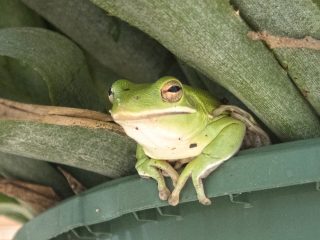
This fine specimen of a Green Treefrog has taken up residence in a hanging basket in my greenhouse. It is a good place for a frog in winter, but unprotected frogs can stand freezing weather in a most surprising way: They freeze! Robert Benson photo.
01/20/2017 – It Is Not Easy Being Green in Winter
Just before that Polar Vortex cold snap hit us a couple of weeks ago, we peeked into the greenhouse to see how our plants were faring. In one of the hanging baskets, we found a Green Treefrog. It was leaning on the edge of the pot, doing what frogs do most of the time: Very little. It blinked a few times, took a breath, and sat there.
It was quite a beautiful specimen. Its lime green body had a white stripe down its side from lip to hip. The frog’s back was dotted with golden spots. Males have slightly wrinkled throats due to the expandable skin needed for vocalizing. (However, I forgot to look closely at his/her throat.) Singing males produce a loud, clear bell-like sound, a “Qu-eenk!” as many as 75 times a minute, during the breeding season. Usually a number of males will congregate at the edges of suitable ponds to croak out their love songs.
Singing males often change their skin color to a yellowish hue. In general, Green Treefrogs can be found in a variety of colors, from yellow-green, to dull green, to a grayish brown. The non-green ones are still identifiable by the white line on their sides. One field guide stated that “color can vary depending on season, from yellow during breeding to dark gray when it is inactive during cold weather.”
Green Treefrogs frequently are found around human habitations. They chase down insect prey among our landscaping and potted plants. Sometimes at night, you can see them on the glass of windows and doors catching insects attracted to the lights. Their big adhesive toe pads allow them to cling to slippery leaves and glass with ease.
We all admired the charming little frog. We figured this treefrog was in a good place for the winter, so we photographed it, and then left it alone.
Then the cold front blew through and dropped temperatures to the teens. Our own thermometer approached eleven degrees Fahrenheit for several hours! Wow! Could our south Texas flora and fauna survive such cold?
Well, as you and I found out, not everything made it through the hard freeze. Tender tropicals were goners, even if we had put covers on them. Broccoli plants, which normally thrive during our winters, froze. Anaqua trees, Texas Persimmon, Colima and other Brush Country shrubs turned brown and lost all their leaves. The countryside is browner than I have seen it in a long time.
Unbeknownst to us the strong wind blew the greenhouse door open. We discovered it a day later. Almost every plant inside suffered considerably, and many are dead. Surprisingly, the hanging basket that had the frog had been in remained green. The plant was a bromeliad. I searched for the Green Treefrog in the pot and inside the tube-like rosettes of leaves. No sign of the frog, not even a body.
I assumed the frog had burrowed into the soil. Texas Toads do this. Or perhaps it hopped over to the pond to go deep in the water and mud. However, I began to wonder: What do frogs do to survive the cold?
Once again, I checked the Internet. I found a reputable Scientific American article titled: “How Do Frogs Survive Winter? Why Don’t They Freeze to Death?” (November 1997). Herpetologist Rick Emmer said that amphibians have several strategies to survive the cold. Mostly they hibernate. The animal finds or prepares a living space (a hibernaculum) to protect it from winter weather and predators, and moves into it. Its metabolism slows down and it “sleeps away” the winter living off its body’s energy stores.
Aquatic species of frogs (Leopard Frogs and Bullfrogs) lie on the muddy bottoms of ponds where they can absorb dissolved oxygen through their skins. Terrestrial frogs (like most toads) burrow deep into the soil to hibernate. However, many frogs are not good at digging. Arboreal species like Green Treefrogs (Hyla cinerea), Wood Frogs (Rana sylvatica), and Spring Peepers (Pseudacris crucifer) must scout out deep crevices in bark, old logs, or rocks. Failing locating such a crack, they dig down as far as they can in the leaf litter. Often the hibernacula they choose are not well protected, and may freeze. The hibernating frogs inside them freeze as well.
Yes, that is what Emmer said: They literally freeze. “And yet they do not die. True enough, ice crystals form in the body cavity, in the bladder, and under the skin, but a high concentration of glucose in the frog’s vital organs prevents freezing. A partially frozen frog will stop breathing, and its heart will stop beating. It will appear quite dead. But when the hibernaculum warms up to above freezing, the frog’s frozen portions will thaw, and the heart and lungs will resume activity.” It wakes up and leaves the hibernaculum, ready for eating and mating.
Unbelievable! Still, I saw the video of a Wood Frog freezing and then coming to life on the Frogsaregreen.org website. Go look at it yourself. You’ll be amazed at the astonishing variety of adaptations Life on Earth has evolved.
If you would like to offer comments, please click through to the discussion
